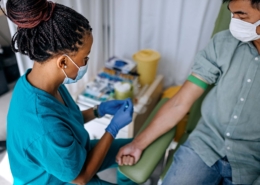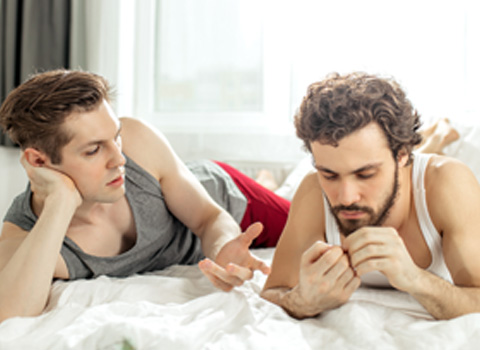 https://carethatfitsyou.org/wp-content/uploads/2023/01/CTFY-Web-image-8315_Undetectable.jpg
325
570
Admin
https://carethatfitsyou.org/wp-content/uploads/2020/04/care-that-fits-you.png
Admin2024-05-20 20:01:352024-06-10 19:21:29Información de la Mpox
https://carethatfitsyou.org/wp-content/uploads/2023/01/CTFY-Web-image-8315_Undetectable.jpg
325
570
Admin
https://carethatfitsyou.org/wp-content/uploads/2020/04/care-that-fits-you.png
Admin2024-05-20 20:01:352024-06-10 19:21:29Información de la MpoxWhat to Expect: Getting Tested for STDs/STIs
Are you sexually active? STDs/STIs are a risk at any age if you’re sexually active with more than one partner or if you and your partners haven’t been tested regularly. If you have never been tested for a sexually transmitted disease (STD)/sexually transmitted infection (STI), or if it has been a while since your last test, here are a few things you should know about getting checked out.
Should you get tested for STDs/STIs?
If you are a man who is actively having sex with other men, the Centers for Disease Control and Prevention (CDC) recommends getting tested for syphilis, chlamydia, and gonorrhea once a year. However, if you’re having sex with multiple partners, you should get tested more frequently—for example, every three to six months. The CDC also recommends getting tested for HIV every three to six months.
In addition to routine screening, you should also seek testing as soon as possible if you are experiencing possible STD/STI symptoms or think you may have been exposed to an STD/STI. Although symptoms vary depending on the type of STD/STI, here are a few things you should look for:
- Unusual discharge from the penis or anus
- Pain when peeing
- Lumps or skin growths around the genitals or anus
- A rash
- Itchy genitals or anus
- Blisters, sores, and/or warts around your genitals or anus
Some STDs/STIs, such as chlamydia, might not cause any symptoms at all. That’s why if you’ve had unprotected sex with a partner who has an STD/STI (or whom you believe might have one), you should get tested even if you’re not experiencing symptoms.
Making an appointment to get tested for STDs/STIs
Getting tested for an STD/STI usually requires an in-person visit, although your provider may offer a telehealth consultation. Contact your health care provider directly to schedule an appointment. If you don’t have a health care provider, you can use the sexual health services locator to find an STD/STI testing clinic near you.
It’s important to note that STD/STI testing may not be included in your regular checkup, so you may have to ask your healthcare provider for it.
Most insurance plans, including MassHealth, cover the cost of STD/STI and HIV testing. Some health clinics and testing sites may offer free or low-cost testing if you do not have health insurance.
If you are on your parents’ or partner’s insurance and are worried about keeping your medical information private, the PATCH Act can help. This is a law that protects your health care information and it will not be shared with anyone but you. It can help you feel comfortable and confident getting the care you need. Here’s how you can request to keep your information private.
At your appointment
Getting tested for an STD/STI is often a quick process, but unfortunately, there isn’t a one-size-fits-all test for every disease.
Since some STDs/STIs, such as chlamydia and gonorrhea, look and act alike, your health care provider might test for a few different infections. In addition, each STD/STI has its own type of test and might require testing from several places on your body. Among the types of tests you might get:
- A urine test. Just like it sounds, you pee into a cup. Urine tests are standard tests to detect gonorrhea and chlamydia.
- A swab test. Your provider takes a sample with a cotton-tipped applicator of fluid from your penis, urethra, cervix, anus, or throat. Swab tests are commonly performed for gonorrhea and chlamydia.
- A blood test. Your provider draws blood from your arm or pricks your finger. Blood tests are most common for HIV, syphilis, and hepatitis.
- A physical exam. Your provider examines your genital area to check for warts, sores, rashes, irritation, or discharge.
During your visit, your health care provider may ask a series of questions about your sexual history, such as if you use condoms or if you’ve had any type of sexual contact involving skin-to-skin genital contact or passing sexual fluids. Your provider may also ask if you have a history of sharing needles or other drug-injection equipment. While you may not be used to sharing personal information like this, it’s best to be open and honest with your provider to get the care you need. Remember that everything you share with your health care provider is confidential.
Getting results
Your health care provider may be able to tell right away if you have an STD/STI, but some tests can take a few days to get results. Ask your provider how long your results should take. If you don’t hear back within the timeframe, follow up with a call.
If your results come back positive, the good news is that most STDs/STIs can be treated or cured. Be sure to follow your provider’s instructions, take your medications as prescribed, and take measures to prevent giving your STD/STI to your sex partners, such as wearing a condom, dental dam, or another barrier method every time you have sex.
Speaking of sex partners, you should also notify anyone you’ve had sex with as soon as you have a diagnosis so that they can get tested and treated. If you’re not comfortable having the conversation, contact the Partner Services Program (PSP), a free service in Massachusetts that helps people who have been diagnosed with STDs/STIs and HIV to notify their partners—and get them the care they need.
When should you get tested for STDs/STIs again?
Just because you’ve had an STD/STI doesn’t mean you can’t get one again. For example, you may take medication to cure gonorrhea, but a new exposure can start a new infection. And if your partner doesn’t get treatment, it’s possible to pass the infection back and forth.
You can take care of your sexual health by taking steps like wearing condoms to lower your risk of STDs/STIs and getting tested whenever you think you might have been exposed.
Looking for PrEP or
other services?
Search for services near you.
Is PrEP right for you?
Take a short quiz to learn more.

























































